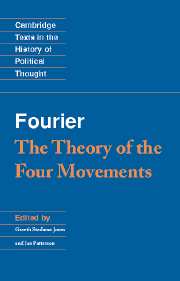Book contents
- Frontmatter
- Contents
- Introduction
- Principal events in Fourier's life
- A brief note on further reading (in English)
- Translator's introduction
- The Theory of the Four Movements and of the General Destinies
- 1808 Introduction
- Preliminary discourse
- Plan
- First part: Exposition of some branches of the general destinies
- Second part: Description of the various branches of the private or domestic destinies
- Third part: Confirmation derived from the inadequacy of the inexact sciences to deal with all the problems that the civilised mechanism presents
- Omitted chapter
- Note A
- Advice to the civilised
- 1818 Introduction
- Index
- Cambridge Texts in the History of Political Thought
Introduction
Published online by Cambridge University Press: 05 June 2012
- Frontmatter
- Contents
- Introduction
- Principal events in Fourier's life
- A brief note on further reading (in English)
- Translator's introduction
- The Theory of the Four Movements and of the General Destinies
- 1808 Introduction
- Preliminary discourse
- Plan
- First part: Exposition of some branches of the general destinies
- Second part: Description of the various branches of the private or domestic destinies
- Third part: Confirmation derived from the inadequacy of the inexact sciences to deal with all the problems that the civilised mechanism presents
- Omitted chapter
- Note A
- Advice to the civilised
- 1818 Introduction
- Index
- Cambridge Texts in the History of Political Thought
Summary
The Theory of the Four Movements appeared in the war–torn France of 1808. By any standards, it was an outlandish, disorganised and disconcerting mixture of ingredients. A well–observed critique of marriage, of the iniquities of free competition leading to ‘industrial feudalism’, of the tedium of work in civilisation and of the errors of the French Revolution was set side by side with assertions about the copulation between planets, oracular pronouncements about the life-span of the earth, extravagant promises about a new religion of ‘voluptuousness’ and a cryptic prospectus of the amorous and gastronomic delights which would accompany it. No author's name appeared on the title page and the place of publication, Lyons, was misleadingly stated to be Leipzig. Finally, whatever the other merits of the book, the exposition of The Theory of the Four Movements itself was bewilderingly brief: barely four pages, much of it in a footnote, scarcely more than the space-filling digression on the sad decline of provincial theatre.
Some of these obscurities can be attributed to worries about censorship during the First Empire. So can some of the circumlocutions. For instance, the war between France and England was prudently renamed ‘the battle against insular monopoly’. The author had already discovered that Bonapartist officials were particularly allergic to military pessimism. But, generally, the bizarre form of the book faithfully reflected authorial intention.
- Type
- Chapter
- Information
- Fourier: 'The Theory of the Four Movements' , pp. vii - xxviPublisher: Cambridge University PressPrint publication year: 1996



